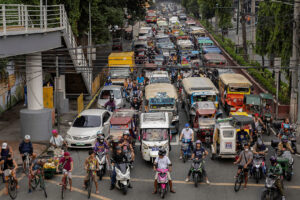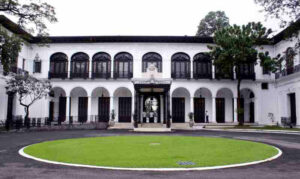BSP chief sees above 6% growth in second quarter

THE PHILIPPINE ECONOMY may have expanded by over 6% in the second quarter, the outgoing governor of the Bangko Sentral ng Pilipinas (BSP) said on Tuesday.
“I think it’s over 6% for this quarter. And for the year, it’s going to be over 6%,” BSP Governor Felipe M. Medalla told reporters on the sidelines of an economic forum in Taguig.
Asked if second-quarter economic growth will be lower than 6.4% in the first quarter, he said “that’s hard to say.”
During his keynote address, Mr. Medalla said the economy appears to be strong this year, but noted it would be harder to post growth “when the base is larger.”
The Philippine gross domestic product (GDP) grew by 6.4% in the first quarter, slower than the 8% expansion in the same period a year ago. The government is targeting 6-7% GDP growth this year.
National Economic and Development Authority (NEDA) Undersecretary Rosemarie G. Edillon said the Philippine economy is projected to outpace many of its regional peers this year despite external challenges.
“We anticipate sustained and robust growth, promising employment figures, and a positive trend towards reaching our inflation target,” Ms. Edillon said, reading the speech for NEDA Secretary Arsenio M. Balisacan.
However, high levels of investment are crucial to sustain the economy’s growth trajectory, she said.
“The Philippines has much to learn from its East Asian neighbors and must catch up with its dynamic Southeast Asian counterparts. Unfortunately, decades of neglect have resulted in significant infrastructure deficits,” she added.
Finance Secretary Benjamin E. Diokno said that productive spending is of “paramount importance.”
“Hence, infrastructure spending must be kept at 5-6% of GDP annually or around P1.3 trillion to P2.3 trillion each year until 2028,” he said in a video presentation at the same forum.
Under the Public Investment Program for 2023-2028, the government identified 3,770 infrastructure priority programs and projects with an indicative investment requirement of about P17.3 trillion.
FED TIGHTENINGMeanwhile, Mr. Medalla said the BSP may find it hard to cut policy rates if there are still risks of further monetary tightening by the US Federal Reserve.
“There are still many risks despite the fact that our forecasts are quite optimistic about [inflation] being below 4% by October or November,” Mr. Medalla said.
Headline inflation slowed to 6.1% in May from 6.6% in April. This marked the 14th straight month inflation was above the central bank’s 2-4% target. Year to date, inflation has averaged 7.5%.
Last week, the BSP extended its policy pause for a second straight meeting, keeping the benchmark rate at 6.25%. The Monetary Board has raised borrowing costs by 425 basis points between May 2022 and March 2023.
“We still have to wait for more data points and the other thing that complicates it is we don’t know what the US is going to do,” Mr. Medalla said.
The Fed paused its tightening at its June meeting but signaled it may still raise borrowing costs this year.
“So clearly it’s very hard to cut if the US is raising rates because for some reasons, the foreign exchange market is very sensitive to the narrowing of the interest rate differential,” Mr. Medalla added.
The Monetary Board will meet next on Aug. 17. — Keisha B. Ta-asan




